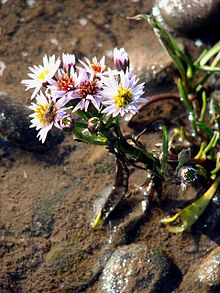
Callistephus is a monotypic genus of flowering plants in the aster family, Asteraceae, containing the single species Callistephus chinensis. Its common names include China aster and annual aster. It is native to China and Korea. and it is cultivated worldwide as an ornamental plant in cottage gardens and as a cut flower.

Leucanthemum is a genus of flowering plants in the aster family, Asteraceae. It is mainly distributed in southern and central Europe. Some species are known on other continents as introduced species, and some are cultivated as ornamental plants. The name Leucanthemum derives from the Greek words λευκός – leukos ("white") and ἄνθεμον – anthemon ("flower"). Common names for Leucanthemum species usually include the name daisy, but "daisy" can also refer to numerous other genera in the Asteraceae family.

Buphthalmum salicifolium is a species of flowering plant in the aster family, Asteraceae. It is known by the common name ox-eye. It is native to Europe.

Aster tataricus, also called Tatarinow's aster, is a member of the Aster genus of flowering plants.

Symphyotrichum lentum is a species of flowering plant in the family Asteraceae with the common name of Suisun Marsh aster. It is a perennial and herbaceous plant endemic to the marshes of Sacramento-San Joaquin River Delta of Northern California.

Solidago nemoralis is a species of flowering plant in the aster family, Asteraceae. It is native to North America, where it is widely found in Canada and the United States. Its common names include gray goldenrod, gray-stem goldenrod, old-field goldenrod, field goldenrod, prairie goldenrod, dwarf goldenrod, and dyersweed goldenrod.

Doellingeria is a genus of flowering plants in the aster family. It contains species formerly included in Aster but now considered to be a distinct genus. They are known commonly as tall flat-topped asters or whitetops.
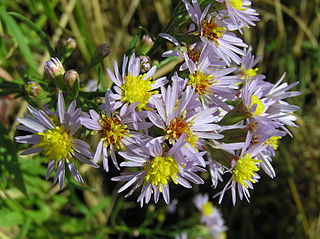
Tripolium is a genus of Eurasian and North African plants in the aster tribe within the sunflower family.

Leucanthemum maximum is a species of flowering plant in the aster family known by the common name max chrysanthemum.
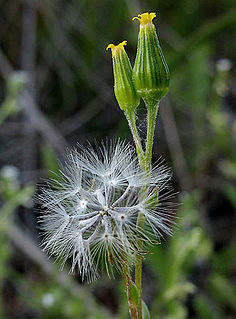
Senecio aphanactis, known by the common names chaparral ragwort, rayless ragwort, and California groundsel, is a species of flowering plant in the aster family.
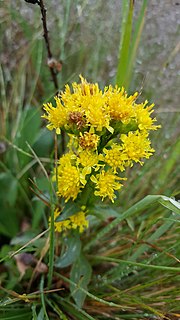
Senecio aronicoides is a species of flowering plant in the aster family known by the common name rayless ragwort. It is native to Oregon and northern and central California, where it can be found in the woodlands and forests of mountains and foothills, often in relatively dry habitat. It is a biennial or perennial herb growing up to about 90 centimeters tall from a fleshy root attached to a buttonlike caudex. The plant is often slightly woolly or cobwebby in texture. The leaves have lance-shaped to oval blades measuring up to 20 centimeters long, the largest ones lower on the stem. The inflorescence is a corymb which is flat and spreading, often resembling an umbel. The flower heads are cups lined with black- or green-tipped phyllaries and filled with many gold disc florets. There are usually no ray florets but one or two occasionally emerge from a head. The fruit is a hairless achene tipped with a pappus of long, white bristles.
Packera indecora is a species of flowering plant in the aster family known by the common names elegant groundsel and rayless mountain ragwort. It is native to northern North America including most of Canada and sections of the northernmost United States. It grows in moist mountain habitat, such as streamsides and meadows.

Thelesperma megapotamicum is a perennial species of flowering plant in the aster family known by the common name wild tea and rayless greenthread. It is native to sections of the Americas, including the central United States, where it grows in many types of habitat.

Acamptopappus sphaerocephalus is a species of flowering plant in the aster family known by the common name rayless goldenhead. It is native to the southwestern United States, where it occurs in southern California, southern Nevada, southern Utah, and Arizona.

Symphyotrichum prenanthoides is a species of flowering plant in the family Asteraceae known by the common name crookedstem aster. It is native to northcentral and northeastern North America.
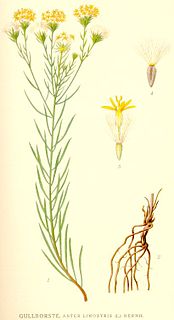
Galatella linosyris is a species of perennial plant from family Asteraceae found in Eastern, Central and Southern Europe. It can also be found in Great Britain, the southern part of Scandinavia and in Asia Minor. The flowers are yellow coloured. The species have stems up to 10–50 centimetres (3.9–19.7 in), with leaves that are lanceolate. The plant does not have ray flowers, only disk florets. It blooms from July to September. The fruits are achenes. The species is under protection in the Czech Republic.

Dittrichia graveolens, commonly known as stinkwort or stinking fleabane, is a plant species in the sunflower family, native to southern Europe, North Africa, and western Asia as far east as Pakistan. It has become naturalized in California, Asia, Africa, Australia, and other places and is regarded as a noxious weed in some regions. It is a classified as an invasive species in California, and a potential threat to wine production in the state.

Bigelowia nuttallii is a species of North American flowering plants in the daisy family, native to the southern United States.
Bigelowia nudata is a species of North American flowering plant in the daisy family. It is native to the coastal plain of the southeastern United States.

Symphyotrichum ciliatus is a species of flowering plant in the family Asteraceae native to North America and eastern Eurasia. Commonly known as rayless annual aster and rayless alkali aster, it is an annual, herbaceous plant that may reach over 70 centimeters tall. Each flower head has many whitish then pink disk florets and no ray florets ("rayless").
